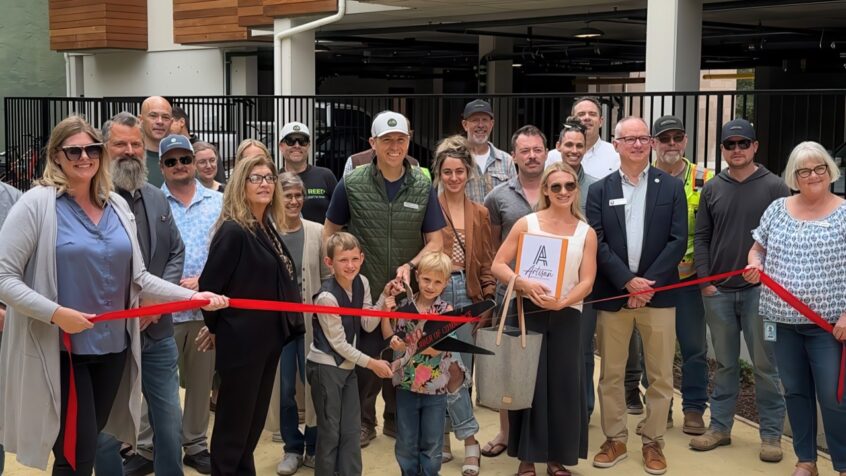At Abbott | Reed, Inc., our mission is to advance the built environment in service to a stronger community.
In the following article, Vice President Aaryn Abbott explores the complexities of fulfilling that mission by “chasing the overlap.”
When I think about housing development, I picture a giant Venn diagram — hundreds of circles overlapping in unpredictable ways.
One circle for land. Another for capital. Others for zoning, labor, design, fees, timing, interest rates, and market demand. Each one moving independently.
If you’re lucky, within that shifting web, a tiny sliver forms — a fleeting overlap where everything lines up: the right land, the right design, the right financing, the right moment. That small slice of alignment is where housing that works lives.
The problem is, those circles never stop moving.
Every Project Is Its Own Universe
No two buildings are the same — even when they’re drawn from the same plans.
They rise from different soils, in different cities, with different neighbors and inspectors. They’re built under different weather, with different trades, under evolving codes, and financed in different market cycles.
You can repeat a floor plan, but not a project. Each one is its own universe of variables — which is part of what makes building so endlessly fascinating, and so endlessly hard.
That uniqueness is both the craft and the curse of construction. It’s why the industry resists automation, and why “standardization” so often fails to deliver. The physics of place and people simply don’t repeat.
The Entitlement Labyrinth
In California, much of the uncertainty lives in the entitlement process — the long stretch where vision meets regulation.
How much will the project change under public input? How many hearings, studies, and conditions will it take? What new requirements will emerge before approval?
Entitlement is supposed to shape good projects, and sometimes it does. But it also introduces the kind of unpredictability that makes capital nervous. Investors and lenders want timelines and numbers; cities offer revisions and subjectivity.
Not only does it take years of experience to anticipate those unknowns, they differ from city to city — and they change constantly.
So, you navigate the maze. You adapt the design, manage the consultants, add another study, revise the pro forma. If you’re persistent — and a little lucky — you emerge on the other side with an approval.
And for a moment, it feels like victory.
The False Finish Line
The truth is, entitlement isn’t the end — it’s the halfway mark.
Because now comes the next question: can you actually afford to build what just got approved?
Yes, you ran the numbers early on. But that was before you knew the exact conditions, before interest rates doubled, before the city added new impact fees, before the bids came back.
You’ve already spent time, money, and energy — finding land, hiring consultants, paying application fees — but now you’re deciding whether to commit fully. Whether to spend the next big tranche of money on construction drawings and permits.
Only after months of coordination and bidding do you learn what it really costs. And it’s rarely good news.
Maybe it’s 10% higher than the last estimate. Maybe more. Suddenly, the project that once penciled doesn’t anymore.
The Waiting Place
At that point, many projects enter what Dr. Seuss might call “the Waiting Place.”
Waiting for rents to rise or interest rates to drop. Waiting for fees to ease, or costs to soften. Waiting for the lender’s call, or the next market cycle, or for someone else to take the risk.
It’s a strange purgatory — part economics, part endurance. Projects get redesigned, resold, and re-entitled while the fundamentals shift around them. Some make it through; many don’t.
Every project we build has a story like this behind it — usually with a few failed versions that paved the way for the one that finally broke ground.
The Real Product Is Alignment
When I look back at the projects that did make it, they all have one thing in common: alignment.
Cities that gave clear, timely feedback. Design teams that balanced ambition with constructability. Lenders and investors who understood both the math and the mission. Builders who could adapt without losing quality. Owners who bring it all together.
Alignment is the real product — everything else is just a tool to achieve it.
Housing that works isn’t a miracle of policy or finance. It’s the result of hundreds of moving pieces finally finding their small, shared overlap — long enough to build something real.
Looking Ahead
The question now is: how do we make that overlap bigger and less fragile?
How do we design cities, codes, and financing systems that don’t depend on perfect timing and luck?
Over the next few months, I’ll explore that question — looking at the policies, design innovations, and construction practices that can make these circles in the Venn diagram bigger, more stable, and more likely to align.
The Mission
At Abbott | Reed, our mission is to advance the built environment in service to a stronger community.
That means chasing that overlap — not just once, but over and over again. It means bringing cities, capital, and construction into alignment long enough to create something lasting.
Because in the end, housing that works isn’t just a structure that stands. It’s a community that grows because someone kept going — through the waiting, the revisions, the shifting circles — until all the pieces finally clicked into place.
